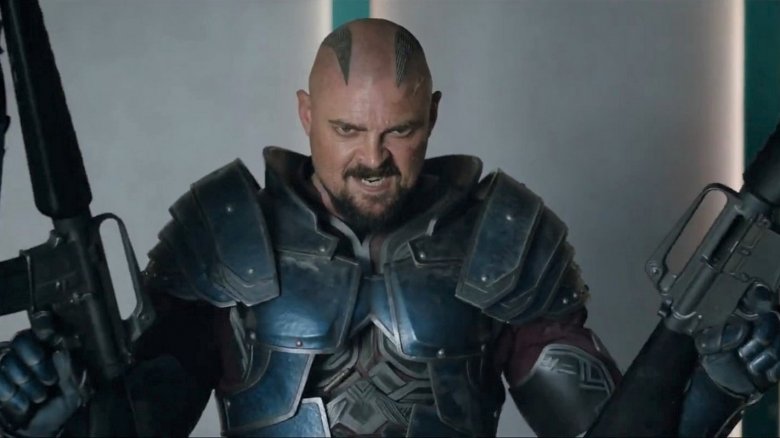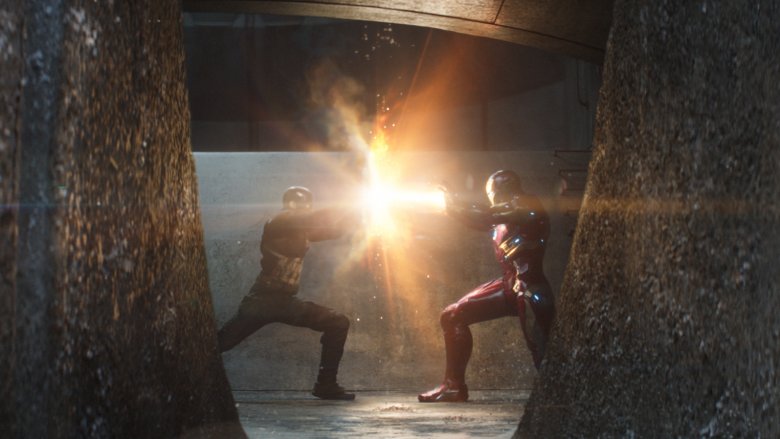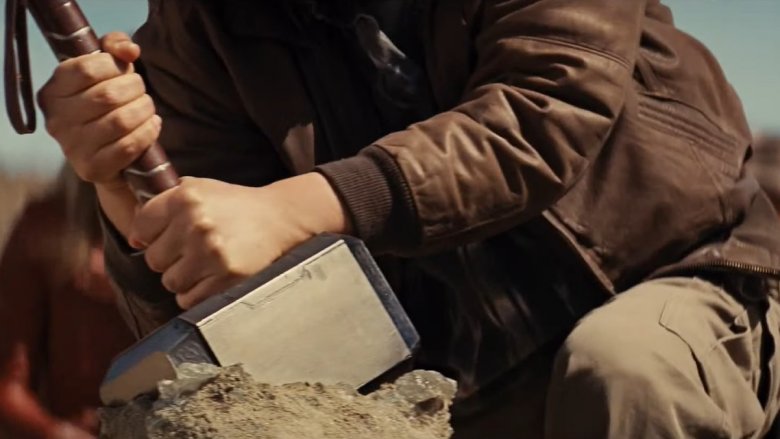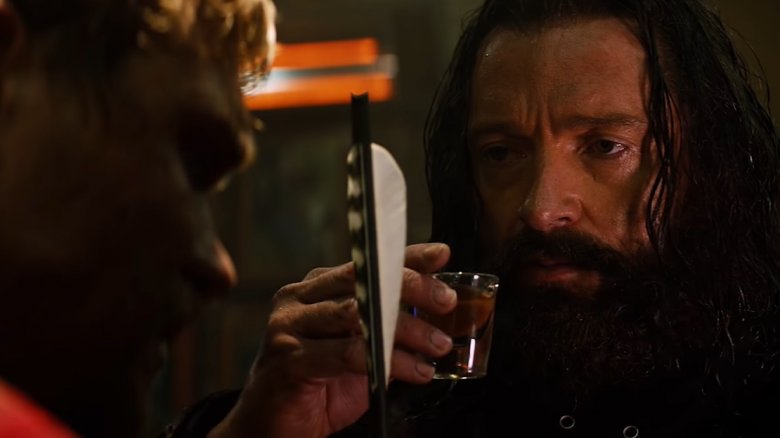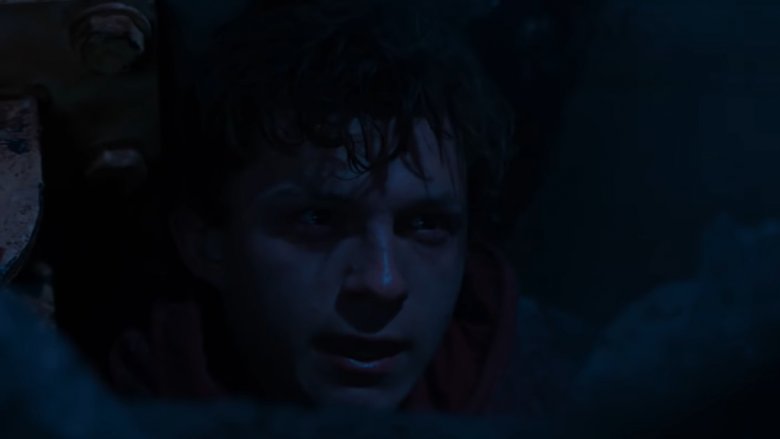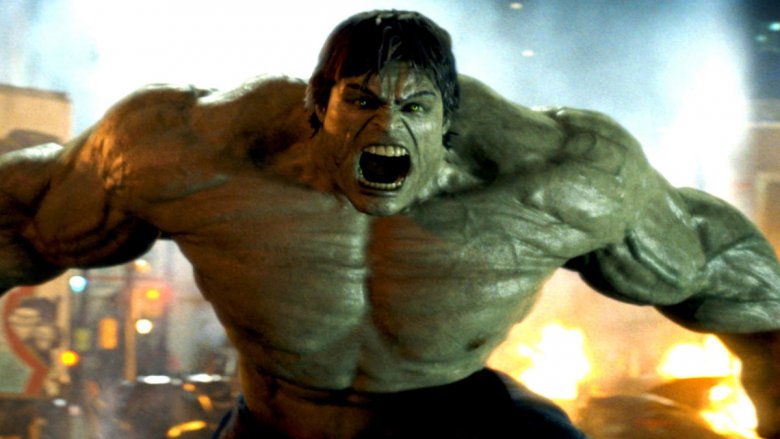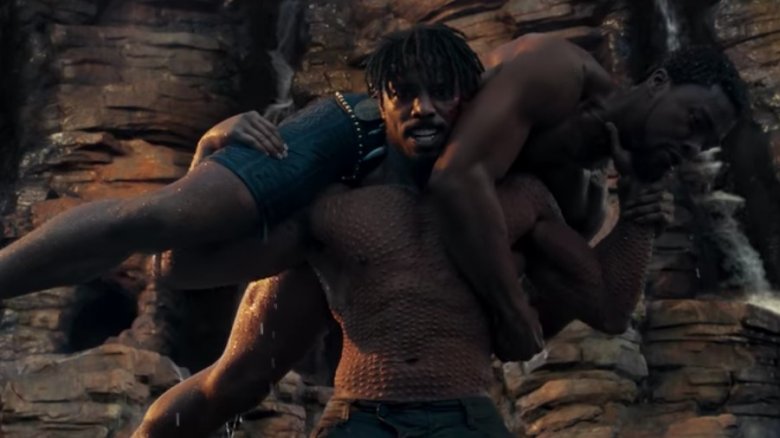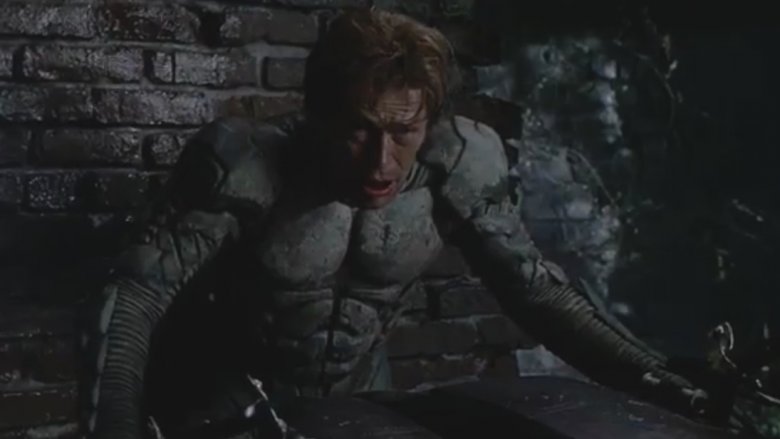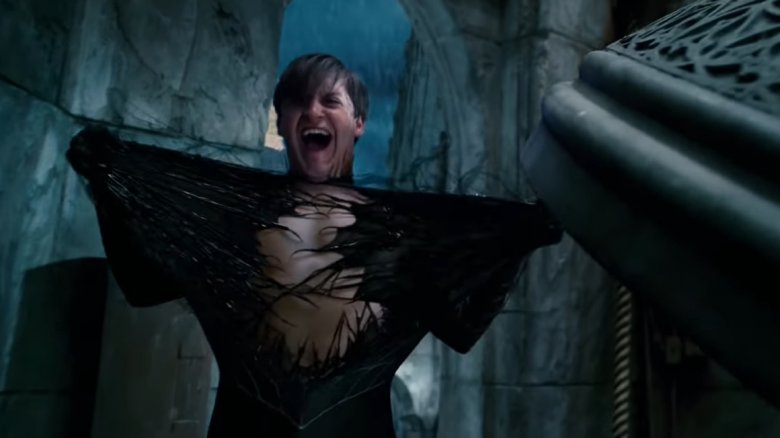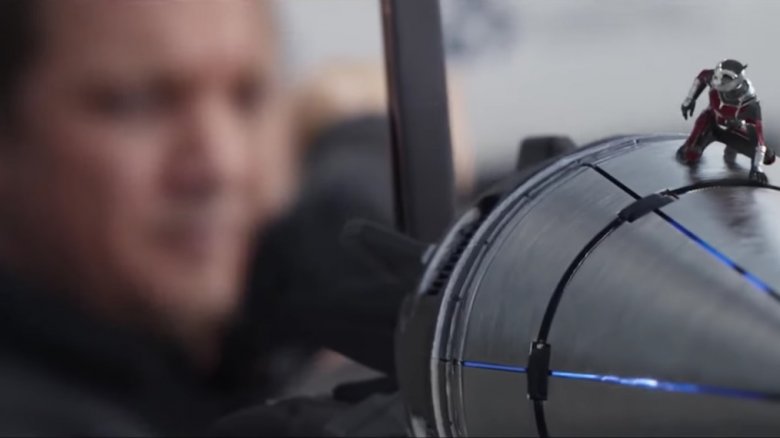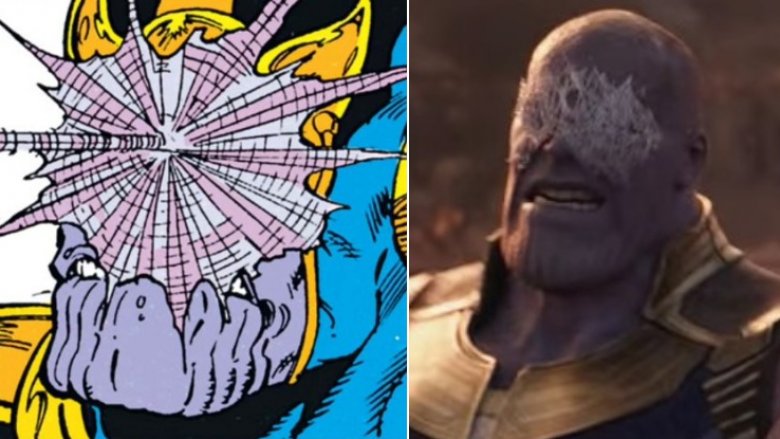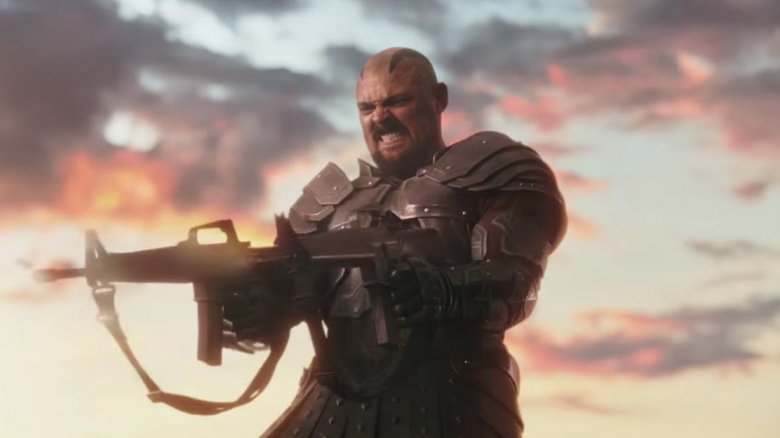Marvel Movie Moments That Copied The Comics Exactly
So much more is possible in a Marvel comic than a movie. The scope of the stories, the size of the cast, and the splendor of the setting are only limited by the talents and imaginations of the comic book creators. As a result, we're treated to grand spectacles and mind-blowing action scenes that are unencumbered by special effects, costume fittings, budgetary restrictions, or any of the issues that can plague a film. And with all that imagination on display, it's no wonder the page so often inspires the screen.
Granted, Marvel movies take place in their own world, separate from the comics for both creative and practical purposes. After all, if Captain America: Civil War had tried to be more like the 2006 Marvel comic, Civil War, we'd probably still be waiting to see it since the films would have to introduce dozens of characters we haven't even seen in the MCU yet. But every now and then, whether it's a simple visual gag or an entire battle scene, filmmakers manage to lift something right from the page. From epic poses to iconic deaths, here are some Marvel movie moments that copied the comics exactly.
Captain America: Civil War copies a very iconic cover
Directed by the Russo brothers, Captain America: Civil War manages to hit most of the major events from 2006's Civil War comic. The conflict between the characters revolves around heroes willing to register and those resisting it, Captain America (Chris Evans) and Iron Man (Robert Downey Jr.) lead the opposing sides, and the inciting event is a bunch of civilians dying during a superhero battle.
There are also big differences, however. Characters who had major roles in the comic like Punisher, the Fantastic Four, the X-Men, the New Warriors, and Namor aren't in the film. The conflict in the comics was isolated to America, while in the film, the legislation comes from the United Nations. Cap is assassinated in the comics, and the fighting has nothing to do with Bucky.
Still, the filmmakers made sure one moment in Captain America: Civil War mirrors the comic in a way that any fan would recognize. During the final showdown between Cap and Iron Man, Steve Rogers charges with his shield raised, and Tony Stark fires his repulsors, causing sparks to fly off Cap's shield. The moment is intentionally made to look like the cover of 2006's Civil War #7 — the final issue of the game-changing miniseries. Sure, in the movie, the setting is different, there aren't piles of knocked-out heroes at their feet, and their outfits don't look quite as battle-damaged as they do on the comic cover. Still, every fan watching the film knew exactly what they were seeing.
Thor pays homage to the comics with some hammer time
The Civil War comic might pit hero against hero, but there's one shocking admission from both the screen and the page: Thor is nowhere to be found in either of them. (Well, unless you count the murderous thunder god clone that Tony Stark and Reed Richards unleash on the anti-registration heroes.) In the movie, Thor was off fixing the nine realms, and in the comics, the hammer-wielding hero had been missing since the events of 2004's Avengers Disassembled.
But while Thor himself isn't around, his presence is felt in the pages of Fantastic Four, just as things are about to get violent in Civil War. In 2006's Fantastic Four #536, Mjolnir falls to Earth and creates a crater in the middle of Oklahoma, like the one we see in New Mexico in the first Thor movie. And while Doctor Doom gives it a go first, eventually a line of Thor wannabes shows up, with everybody getting their chance to fail at lifting the legendary hammer.
Finally, in Fantastic Four #538, Thor's old alter ego, Dr. Donald Blake, arrives on the scene and refuses to wait in line. Easily fighting his way past the other "candidates," Blake eventually grabs a hold of Mjolnir and disappears in a column of light. While the film skips all that (plus a battle between the Fantastic Four and Doombots), we do get to see all the hopefuls try their hand at the hammer, including Stan Lee.
Logan fights a hunter on more than one occasion
Logan is a broken man at the end of X-Men: The Last Stand. He's killed Jean Grey (Famke Janssen), and even though he had to do it, the superhero refuses to forgive himself. So when we pick up the story in 2013's The Wolverine, we discover the mutant hero (Hugh Jackman) has become a hermit in the Canadian wilderness, complete with Cast Away-style beard and hair. (Sadly, there are no volleyballs around.) But life isn't easy out in the woods, as Logan is forced to kill a bear drugged by a poison-tipped arrow. That poison drove the bear crazy, leading it to kill five people, and now Logan is tracking down the hunter responsible. After all, the Wolverine intends to get justice for the family and the bear.
Everything from this part of the film is lifted directly from 1982's Wolverine #1, which opens with Logan first tracking down the killer bear and subsequently finding the hunter responsible for its bloody rampage. Granted, in the comic, Logan isn't a hermit at the time, and he isn't suffering from any more guilt than usual. Plus, comic creators Frank Miller and Chris Claremont leave most of Logan's confrontation with the hunter to our imagination. In the film, however, Logan tortures the hunter by pinning his hand to a table with the very poisoned tipped arrow he pulled from the bear's corpse. In other words, don't mess with the Wolverine or his fuzzy friends.
Spider-Man is buried alive in both the movie and the comic
One of the greatest moments in web-slinging history comes in 1966's Amazing Spider-Man #33. The issue opens with Spider-Man trapped under tons of steel after a battle with Doctor Octopus. In a five-page sequence some fans consider to be the late Steve Ditko's defining moment on the series, Spidey first resigns himself to failure and death, only to rally and — through sheer force of will — force the pile of rubble from his back.
This scene definitely inspired director Jon Watts and the creative team behind Spider-Man: Homecoming. In this super-powered adventure, Peter Parker (Tom Holland) finds himself trapped under tons of cement. Instead of Dock Ock, it's the Vulture (Michael Keaton) who put Spidey in this position, but the results are still the same. At first Peter is defeated, uselessly crying out for help. We don't get the same dramatic monologue Stan Lee wrote for Amazing Spider-Man #33, with Spidey swearing to not fail his sweet Aunt May, but just like the comic, movie Spider-Man frees himself with a simple, undeniable refusal to fail.
Both the movie and the comic deliver Hulk on a helicopter
In the early aughts, Marvel unveiled its "Ultimate" line of comics, featuring its classic characters with more updated stories. A lot of that updating involved graphic violence, and few characters were more blatant examples of this than Bruce Banner.
The Hulk first raged into the Ultimate universe in Ultimate Marvel Team-Up, but he doesn't become a murderous, cannibalistic Hulk until he shows up in Ultimates. After his first rampage through New York City, Banner is kept in a prison very much like the one designed for him in 2012's Avengers. Hulk is then absent for most of Ultimates, but the stage is set for his return at the end of Ultimates #12. While the Ultimates battle the invading Chitauri, Banner is confined in a straitjacket and flown over the battle in a helicopter, where a S.H.I.E.L.D. soldier beats Banner and throws him out of the chopper. Predictably, the following issue opens with the Hulk crashing to the ground and serving as the turning point in the fight.
In 2008's The Incredible Hulk, we get a much more romantic version of this moment. Captured by General Ross (William Hurt) and having learned Emil Blonsky (Tim Roth) has transformed into the Abomination, Banner (Ed Norton) volunteers to morph into the Hulk and fight the roided-up rage monster. But rather than being forced out, Banner willingly falls from the helicopter into a besieged Harlem after getting a kiss from Betty (Liv Tyler). It's a nice nod to the comics, but it's too bad the movie was such a disaster.
T'Challa takes a fall on the page and the screen
When he was first introduced in 1973's Jungle Action #6, Erik Killmonger's quest for power didn't really involve the desire for global political change. But when Michael B. Jordan showed up in Black Panther, the supervillain was all about starting revolutions. However, the character's first appearance ends the same way in both mediums, with Killmonger hurling T'Challa (Chadwick Boseman) from the top of Warrior Falls.
Other than Killmonger's motivations, the biggest difference between the Warrior Falls fight scenes is how Killmonger defeats his royal foe. In the movie, Killmonger challenges T'Challa to ritual combat. Similar to his battle with M'Baku (Winston Duke), the Panther's powers are stripped from him, and the fight that follows is a fair, one-on-one conflict. However, in Jungle Action #6, T'Challa returns to Wakanda to find his land divided, courtesy of Killmonger. The Panther tracks his enemy down, but when they finally square off, Killmonger calls in some backup: his leopard friend, Preyy. While T'Challa defeats the big cat, the battle leaves him weak and wounded, so Killmonger has no problem tossing Black Panther from the falls. Yeah, we're thinking Killmonger from the movie is way cooler than Killmonger from Jungle Action #6.
Marvel killed Green Goblin the same way twice
In 1973, Amazing Spider-Man #121 ended with the death of Peter Parker's girlfriend, Gwen Stacy, during a battle with the Green Goblin. It's a moment often cited as one of the most pivotal moments of comic book history, and the moment when the Silver Age of comics graduated into the more mature Bronze Age. After Stacy's death, the following issue sees Spider-Man pursue the Green Goblin, and their battle ends with the Goblin's demise.
Sam Raimi, director of all three Toby Maguire-led Spider-Man films, pays tribute to the story of Gwen Stacy's tragic death in 2002's Spider-Man in more ways than one. Rather than Stacy, Green Goblin (Willem Dafoe) takes Mary Jane Watson (Kirsten Dunst) as his hostage, but fortunately, MJ survives her encounter with the supervillain. However, most of the fight between Spidey and the Goblin shares Amazing Spider-Man #121's setting of the Brooklyn Bridge.
Later, Osborn dies in exactly the same manner as his comic book counterpart. In the film, while trying to convince Parker that he's reformed, Goblin sends his glider after the hero. Spidey senses the coming danger and gets out of the way, leaving Osborn to be pinned to a brick wall by his own weapon. He utters his famous last words, "Peter ... don't tell Harry," and then gives up the green ghost. In the comic, things unfold pretty much the same, except that Green Goblin makes no attempt to fool Spidey into thinking he's a good guy, and once the glider pins him, he has nothing left to say.
Spider-Man 3 copies that bell tower showdown
The death of Green Goblin isn't the only way Sam Raimi's Spider-Man series copied the comics. In Spider-Man 3, after the alien symbiote forces Peter Parker into morally questionable deeds as well as embarrassing musical acts, Peter is finally shaken loose from the alien's control after he hurts Mary Jane. Spidey is then able free himself from the symbiote by heading to a church, where a clanging bell proves to be the alien's undoing. As the bell tolls, it weakens the symbiote enough that Parker can rip it off his body for good.
The bell tower scene is taken directly from 1985's Web of Spider-Man #1. Parker first gets rid of the symbiote with the help of genius Reed Richards in 1984's Amazing Spider-Man #258. But in Web of Spider-Man #1, the alien escapes from Richards' lab and searches for its old host. It finds Parker, attaches itself to him, and Spidey is forced to escape the alien and fight a gang of winged bank robbers at the same time. He finally reaches a church tower, where the clanging bells defeat the venomous parasite. And fortunately for everyone, Topher Grace is nowhere in sight.
Ant-Man and arrow guy make a marvelous pair in more than one medium
While you could argue the Ant-Man (Paul Rudd)/Hawkeye (Jeremy Renner) team-up in Captain America: Civil War is actually a two or three part tribute, it's most blatantly a copycat of the cover to 1982's Avengers #223, which features Scott Lang hanging on to an arrowhead for dear life. However, in the comics, these two Avengers aren't fighting Iron Man. Instead, they've teamed up against the villain Taskmaster, and Hawkeye launches Ant-Man into the air with an arrow so the tiny hero can diffuse an explosive.
What happens after Hawkeye lets the arrow loose in Captain America: Civil War is also an homage to Marvel's comics, though in a roundabout way. When Ant-Man begins dismantling Tony Stark's suit from the inside, longtime Iron Man readers were likely reminded of 1980's Iron Man #133, though Ant-Man has very different intentions in that comic. Iron Man #133 follows an epic two-part battle between Tony Stark and the Hulk. Tony wins the fight, but his suit is inoperable, leaving him trapped inside, so Ant-Man shrinks so he can enter the suit and fix it. That makes the homage from Civil War something of a double-decker tribute, in that Iron Man #133 itself was a callback to 1971's Avengers #93, in which the original Ant-Man (Hank Pym) shrinks and enters the android body of the Vision to revive him. So yeah, with these references inside references, it's basically Marvel-ception.
Avengers: Infinity War copies a Spider-Man move from the comics
In Avengers: Infinity War, Spider-Man steps up to the plate on Titan during the battle with Thanos (Josh Brolin) by covering the villain's eyes with his trademark webbing. The web-in-your-eye scene perfectly mirrors a moment in 1991's Infinity Gauntlet #4, when Spidey enters the fight in pretty much the same way. After the Mad Titan has already defeated most of Marvel's surviving heroes, Spider-Man hits him in the face with his webs, kicks him in with both feet, and then leaves it to Thor to finish up the melee.
Unfortunately, the movie Spider-Man actually fares a lot better than the comic book version. Drax (Dave Bautista) and Doctor Strange (Benedict Cumberbatch) join the fight right after Spidey webs up Thanos, and shortly afterward, Spider-Man and Doctor Strange deliver "magic with a kick" against the Mad Titan. But in the comics, right after his boots hit Thanos' face, Spidey is beaten to death by Terraxia — a fierce Gauntlet-created warrior woman loyal to Thanos. Of course, Peter Parker comes back by the end of the series, just like everyone else, so no harm, no foul.
Thor: Ragnarok copied Skurge's last stand
In 2017, Thor: Ragnarok lifted one of the most heroic moments from Marvel's long narrative history. Skurge (Karl Urban) finally finds his courage as Hela's (Cate Blanchett) undead hordes storm the Asgardian refugee ship. Throwing off his disguise and revealing his M-16s, Skurge single-handedly holds off the zombie hordes until Hela finally kills him.
The scene is taken from the 1985 classic Thor #362, written and drawn by Thor fan-favorite Walt Simonson. As impressive as Thor: Ragnarok is, Skurge's last stand in the comics is much more emotionally powerful. Skurge is part of a group of Asgardians fleeing Hel (the realm of the dead), and he overhears Thor planning to hold off Hela's demons so the rest of the Asgardians can escape. That's when Skurge knocks Thor out from behind, and now it's the machine gun-toting hero standing alone at Gjallerbru, the bridge spanning the gap between Hel and the lands of the living.
We never actually see Skurge's death, though it's clear he meets his end. We get two beautiful pages of Skurge blasting away at the oncoming hordes, knowing his time is short. Finally, Skurge stands atop a pile of corpses, swinging an M-16 like a club and going out like a warrior. While Thor: Ragnarok is a fantastic film, the comic does a phenomenal job of giving Skurge a worthy death.
